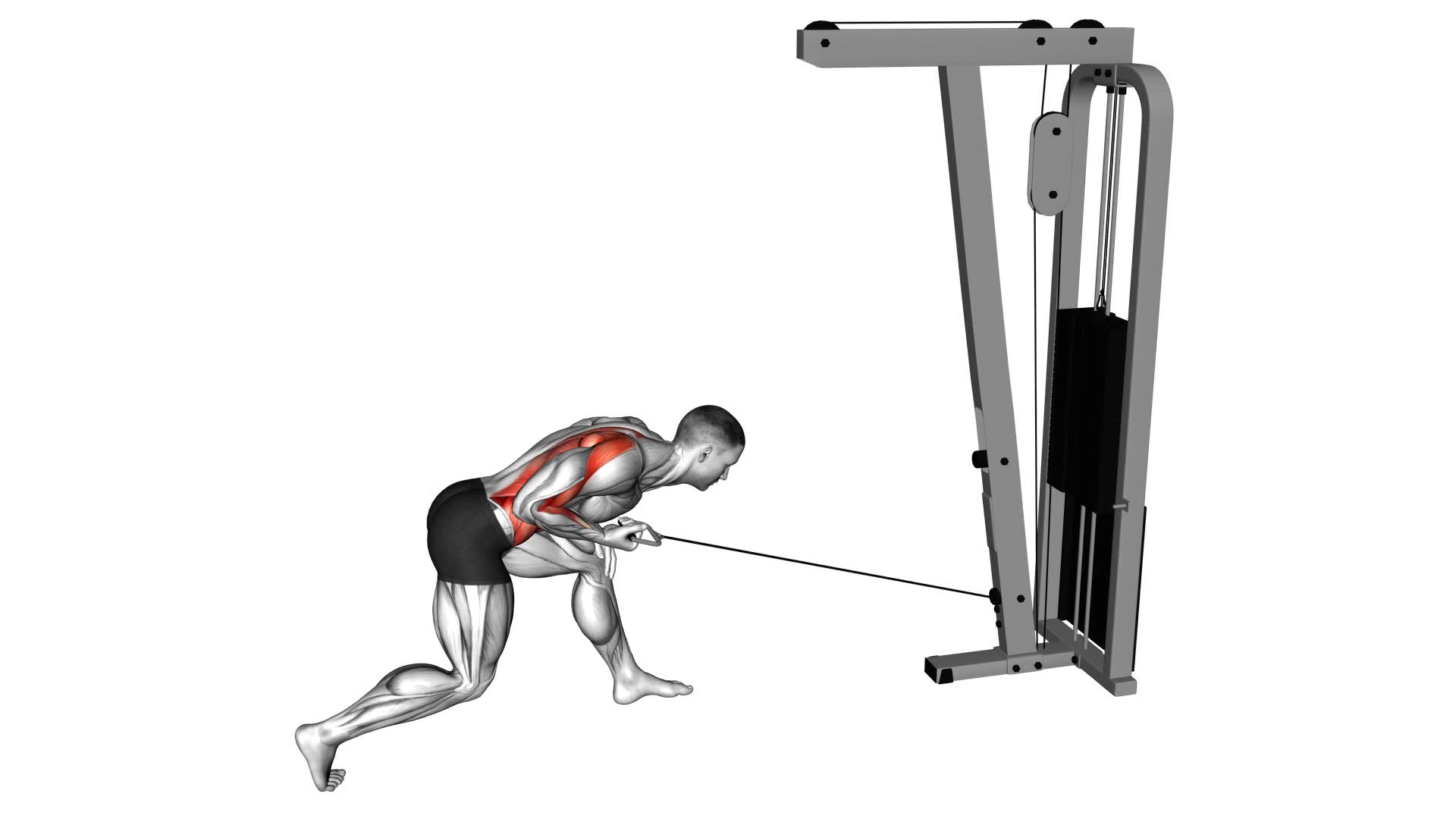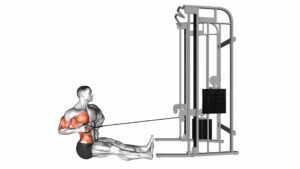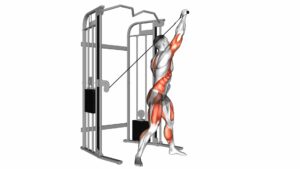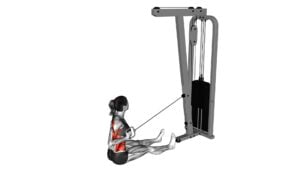Cable Twisting Pull – Video Exercise Guide & Tips

Get ready to level up your fitness routine with the Cable Twisting Pull! This video exercise guide and tips will show you how to properly perform this exercise to target your muscles and maximize effectiveness.
Watch This Exercise Video
Whether you're a beginner or an experienced fitness enthusiast, this exercise has variations and modifications to suit your fitness level.
So grab the cable machine, watch the video, and get ready to twist and pull your way to a stronger, more toned body.
Let's get started!
Key Takeaways
- Cable Twisting Pull targets multiple muscle groups simultaneously, including back muscles, oblique muscles, and core muscles.
- Engaging the core throughout the exercise is crucial for stability and to protect the lower back from potential injuries.
- Maintaining proper shoulder alignment and keeping shoulders relaxed and away from the ears is important for shoulder stability and injury prevention.
- Variations and modifications can be made to increase or decrease resistance, adjust range of motion, and target specific muscle groups. Consulting a fitness professional for personalized modifications and progressions is recommended.
Benefits of the Cable Twisting Pull
One major benefit of the Cable Twisting Pull is that it targets multiple muscle groups simultaneously. This exercise involves pulling the cable towards your body while rotating your torso. As you do this, you engage your back muscles, including the latissimus dorsi, rhomboids, and trapezius. Additionally, the twisting motion engages your obliques, which are the muscles on the sides of your abdomen. By incorporating these muscle groups, the Cable Twisting Pull helps to improve your overall upper body strength and stability.
Another benefit of the Cable Twisting Pull is that it improves your core strength. The rotational movement activates your deep core muscles, including the transverse abdominis and the internal and external obliques. These muscles play a crucial role in stabilizing your spine and maintaining proper posture. Strengthening your core not only enhances your performance in other exercises but also helps to prevent injuries and improve your everyday movements.
Furthermore, the Cable Twisting Pull can also enhance your sports performance. The rotational movement mimics many actions in sports, such as swinging a baseball bat or a golf club. By training these movements, you can improve your power, coordination, and rotational stability, making you more efficient and effective in your chosen sport.
Equipment and Setup for the Exercise
To properly execute the Cable Twisting Pull exercise, you'll frequently need to use the cable machine and set it up for the exercise. The cable machine is a versatile piece of equipment that allows for a smooth range of motion and adjustable resistance.
To set up the cable machine, start by attaching a handle or a rope attachment to the pulley at chest height. Make sure the cable is securely fastened and the handle is comfortable to grip. Stand facing the machine with your feet shoulder-width apart and knees slightly bent. Grab the handle with both hands, palms facing each other. Adjust the weight stack according to your fitness level. Start with a lighter weight and gradually increase as you become more comfortable with the exercise.
Keep your core engaged and maintain a strong posture throughout the exercise.
Now that you have set up the equipment, you're ready to perform the Cable Twisting Pull exercise.
Proper Form and Technique for the Cable Twisting Pull
To perform the cable twisting pull with proper form and technique, there are three key points to keep in mind.
First, focus on engaging your core throughout the exercise to maintain stability and control.
Second, ensure proper shoulder alignment by keeping your shoulders down and back, away from your ears.
Core Engagement Importance
Engage your core properly and maintain correct form and technique when performing the Cable Twisting Pull. Core stability is crucial for this exercise as it helps to stabilize your torso and prevent any unnecessary movements.
By engaging your core, you create a solid foundation and support for your body, allowing you to perform the exercise with more control and efficiency. To engage your core, imagine pulling your belly button towards your spine and maintain this contraction throughout the entire movement. This won't only enhance the effectiveness of the exercise but also protect your lower back from potential injuries.
Now, let's move on to the next section, where we'll discuss the importance of proper shoulder alignment in the Cable Twisting Pull.
Proper Shoulder Alignment
You should make sure your shoulders are properly aligned when performing the Cable Twisting Pull. Proper shoulder alignment is crucial for shoulder stability and to prevent injuries. Here are some important points to keep in mind:
- Maintain a neutral spine: Keep your spine straight and avoid rounding your back during the exercise. This will help to maintain proper alignment throughout your entire body.
- Engage your core: Activate your core muscles by drawing your belly button towards your spine. This will provide stability and support to your shoulders.
- Avoid shrugging your shoulders: Keep your shoulders relaxed and away from your ears. Shrug-free shoulders will help to prevent unnecessary tension and strain.
Avoiding Excessive Momentum
Maintain proper form and technique for the Cable Twisting Pull by avoiding excessive momentum during the exercise. One common mistake to avoid is using your body's momentum to swing the cable handle, which reduces the effectiveness of the exercise. Instead, focus on using your core muscles to initiate the movement and control the cable handle throughout the entire range of motion.
Keep your shoulders relaxed and your chest lifted, engaging your abs and obliques as you twist. Another important aspect is to progress gradually with the weight. Start with a lighter resistance and gradually increase it as your strength improves. This ensures that you maintain proper form and avoid putting undue stress on your joints.
Targeted Muscles and Muscle Groups
The cable twisting pull targets the muscles and muscle groups involved in rotational movements. This exercise is an effective way to build core stability and strengthen the oblique muscles.
Here are three key muscle groups that are targeted during the cable twisting pull:
- Core muscles: The twisting motion engages the deep core muscles, including the transverse abdominis and the internal obliques. These muscles play a crucial role in stabilizing the spine and maintaining good posture.
- Oblique muscles: The cable twisting pull specifically targets the oblique muscles, which are located on the sides of the abdomen. These muscles are responsible for rotating and bending the torso, and they play a crucial role in everyday functional movements.
- Latissimus dorsi: The cable twisting pull also engages the latissimus dorsi muscles, which are the large muscles of the back. These muscles assist in the rotational movement and provide stability to the shoulders and spine.
By targeting these muscles, the cable twisting pull helps to improve core stability and enhance rotational strength.
Now, let's explore the variations and modifications for different fitness levels to further enhance your workout routine.
Variations and Modifications for Different Fitness Levels
To progress your cable twisting pull workout and cater to various fitness levels, consider incorporating variations and modifications. These options allow you to challenge yourself or make the exercise more accessible based on your individual needs.
One variation you can try is adjusting the weight resistance. If you're looking for more intensity, increase the weight on the cable machine. This will require more strength and engage your muscles even further. On the other hand, if you're a beginner or want to focus on perfecting your form, start with lighter weights. This will allow you to concentrate on the movement and build a strong foundation.
Another modification you can make is changing the speed of the exercise. Slowing down the twisting pull will increase the time under tension and enhance muscle engagement. This can be especially beneficial for advanced individuals who are looking to maximize their gains. On the contrary, if you're new to this exercise or have any limitations, you can perform the twisting pull at a slower pace or even pause between repetitions. This will reduce the intensity and provide a safer and more manageable option.
Tips for Maximizing the Effectiveness of the Cable Twisting Pull
To get the most out of your cable twisting pull workout, here are some tips to maximize its effectiveness:
- Maintain proper form: Keep your core engaged and your back straight throughout the exercise. This will help target the muscles in your upper body more effectively and prevent injuries.
- Use the appropriate weight: Start with a weight that challenges you but still allows you to perform the exercise with proper form. Gradually increase the weight as you get stronger to continue maximizing results.
- Focus on controlled movements: Avoid using momentum to swing the cable handle. Instead, concentrate on slow and controlled movements, emphasizing the contraction of the muscles.
- Avoid common mistakes: One common mistake is pulling the cable handle too far across your body. Instead, focus on a controlled range of motion and avoid excessive twisting. Another mistake is neglecting the opposite side of your body. Remember to work both sides equally for balanced muscle development.
- Incorporate variations: To challenge your muscles in different ways, try incorporating variations of the cable twisting pull, such as performing it from a kneeling position or using a single-arm pull.
- Rest and recover: Give your muscles time to rest and recover between workouts to maximize results. Aim for at least one day of rest between sessions.
Frequently Asked Questions
How Many Sets and Repetitions Should I Perform for the Cable Twisting Pull Exercise?
To determine how many sets and repetitions to perform for the cable twisting pull exercise, consider your fitness level and goals. Start with 2-3 sets of 10-12 repetitions and gradually increase as you get stronger.
This exercise targets your core, back, and shoulders, improving stability and strength. Adding the cable twisting pull to your routine can enhance your overall upper body strength and help develop a strong and toned physique.
Can the Cable Twisting Pull Exercise Be Done Using Resistance Bands Instead of a Cable Machine?
Yes, you can perform the cable twisting pull exercise using resistance bands instead of a cable machine. Resistance bands offer a convenient and portable alternative to cable machines, allowing you to target the same muscles and achieve similar results.
Additionally, resistance band exercises provide benefits such as improved muscle strength, flexibility, and stability. So, whether you choose a cable machine or resistance bands, you can effectively engage your muscles and achieve your fitness goals.
Is the Cable Twisting Pull Exercise Suitable for Individuals With Lower Back Issues?
The cable twisting pull exercise can be modified for individuals with lower back issues. By using lighter weights or resistance bands, you can reduce the strain on your back while still targeting your core muscles.
This exercise is beneficial for strengthening your core and improving stability. It engages the muscles in your abdomen, obliques, and lower back, helping to support your spine and prevent injuries.
Remember to consult with a fitness professional or healthcare provider before starting any new exercise routine.
Can I Incorporate the Cable Twisting Pull Exercise Into My Upper Body Workout Routine?
Yes, you can definitely incorporate the cable twisting pull exercise into your upper body workout routine. It's a great exercise that targets your upper body muscles, including your back, shoulders, and arms.
By adding this exercise to your routine, you can improve your upper body strength, stability, and overall muscle tone.
It's important to perform the exercise with proper form and start with lighter weights before gradually increasing the resistance to avoid any injuries.
Are There Any Alternatives to the Cable Twisting Pull Exercise That Target the Same Muscle Groups?
Looking for alternatives to target the same muscle groups as the cable twisting pull exercise? There are a few options you can consider.
One option is the dumbbell row, which works your back and core muscles.
Another alternative is the resistance band twist, which targets your obliques and shoulders.
If you prefer bodyweight exercises, you can try the plank with a twist or the Russian twist.
These exercises can provide similar benefits to the cable twisting pull.
Conclusion
In conclusion, the cable twisting pull is a highly effective exercise for targeting multiple muscles in your upper body, including your shoulders, back, and core.
By using proper form and technique, you can maximize the effectiveness of this exercise.
Additionally, the cable twisting pull can be modified to suit different fitness levels, making it a versatile option for anyone looking to improve their strength and stability.
Incorporate this exercise into your routine for a challenging and rewarding workout.

Author
Years ago, the spark of my life’s passion ignited in my mind the moment I stepped into the local gym for the first time. The inaugural bead of perspiration, the initial endeavor, the very first surge of endorphins, and a sense of pride that washed over me post-workout marked the beginning of my deep-seated interest in strength sports, fitness, and sports nutrition. This very curiosity blossomed rapidly into a profound fascination, propelling me to earn a Master’s degree in Physical Education from the Academy of Physical Education in Krakow, followed by a Sports Manager diploma from the Jagiellonian University. My journey of growth led me to gain more specialized qualifications, such as being a certified personal trainer with a focus on sports dietetics, a lifeguard, and an instructor for wellness and corrective gymnastics. Theoretical knowledge paired seamlessly with practical experience, reinforcing my belief that the transformation of individuals under my guidance was also a reflection of my personal growth. This belief holds true even today. Each day, I strive to push the boundaries and explore new realms. These realms gently elevate me to greater heights. The unique combination of passion for my field and the continuous quest for growth fuels my drive to break new ground.







